Lord Admirals of England
The office of Lord High Admiral was the most senior naval office in England. During the period 1485 – 1625, there was no navy as we would understand it today. The Crown owned some ships, but in time of war would charter ships either from other monarchs, or from merchants.
In 1513, Henry VIII wanted to charter his brother-in-law, James IV’s, enormous vessel the ‘Great Michael’, for his war with France. James’ refusal – he was allied to France – severely damaged the relationship between them, and was one of the contributing factors in the Anglo-Scottish war that culminated at Flodden.
Henry VIII was interested in ships, and committed to increasing the number he owned. He commissioned several, including the Peter Pomegranate, the Katherine Pleasaunce, the Mary Willoughby, the Henry Grace a Dieu (the Great Harry) and, most famously, the Mary Rose.
The office of Lord Admiral therefore grew in importance. It was expected that appointees would take an active part in naval life, inspecting and commanding ships, and using them for both offensive and defensive warfare. With no professional navy, there was no possibility of the office being held by a career sailor – instead, it was held by men directly appointed by the monarch.
The Lord Admiral would be supported by Vice-Admirals.
| Name | Years of service |
| |
| John de Vere, | 1485 – 1513 | Henry VII’s chief commander at Bosworth. Died in office. | |
|---|---|---|---|
| Sir Edward Howard | 1513 - 1513 | Son of the Earl of Surrey. Lost at sea during the French war. | |
| Sir Thomas Howard, | 1513 - 1525 | Brother of Sir Edward Howard. Held numerous military commands. | |
| Henry Fitzroy, | 1525 - 1536 | Henry VIII’s illegitimate son. Held as an honorary title. Died in office | |
| Sir William Fitzwilliam, Earl of Southampton | 1536 - 1540 | A close friend of Henry VIII. He brought Anne of Cleves from Calais to England. | |
| John, Lord Russell | 1540 – 1542 | Resigned to take up role of Lord Privy Seal. | |
| Sir Edward Seymour, | 1542 – 1543 | Hertford’s strength was as an army, rather than navy, commander. | |
| Sir John Dudley, | 1543 - 1547 | Commanded successfully during the French wars of the early 1540s. Witnessed the sinking of the Mary Rose, with his vice-admiral, Sir George Carew, on board. | |
| Sir Thomas Seymour, Baron Sudeley | 1547 - 1549 | Vice-Admiral to Lisle, he obtained the office from his brother, Lord Protector Somerset. Seymour was accused of involvement with piracy and counterfeiting. He was executed in 1549. | |
| Sir John Dudley, | 1549 – 1550 | After the death of Seymour, the office was again taken by John Dudley. | |
| Edward Fiennes de Clinton, Lord Clinton |
| Commanded the fleet during the campaign that culminated in the Battle of Pinkie and during the English campaign in the war with France of 1557, although no longer Lord Admiral. | |
| Sir William Howard, Baron Howard of Effingham | 1554 - 1558 | Half-brother of Sir Edward Howard and the 3rd Duke of Norfolk, he greeted Philip of Spain in 1554, and commanded the fleet during the 1557 campaign against France. He was one of the negotiators of the Treaty of Cateau-Cambresis. | |
| Edward Fiennes de Clinton, Lord Clinton | 1558 – 1585 | Resumed office. | |
| Sir Charles Howard, | 1585 – 1619 | Commanded the English fleet during the Spanish Armada. | |
| Sir George Villiers, | 1619 - 1628 | The favourite of both James VI & I and his son, Charles I, he accompanied the young Charles to Spain in search of a wife. Whilst personally brave in naval campaigns, he was an inept politician and was eventually assassinated. |



